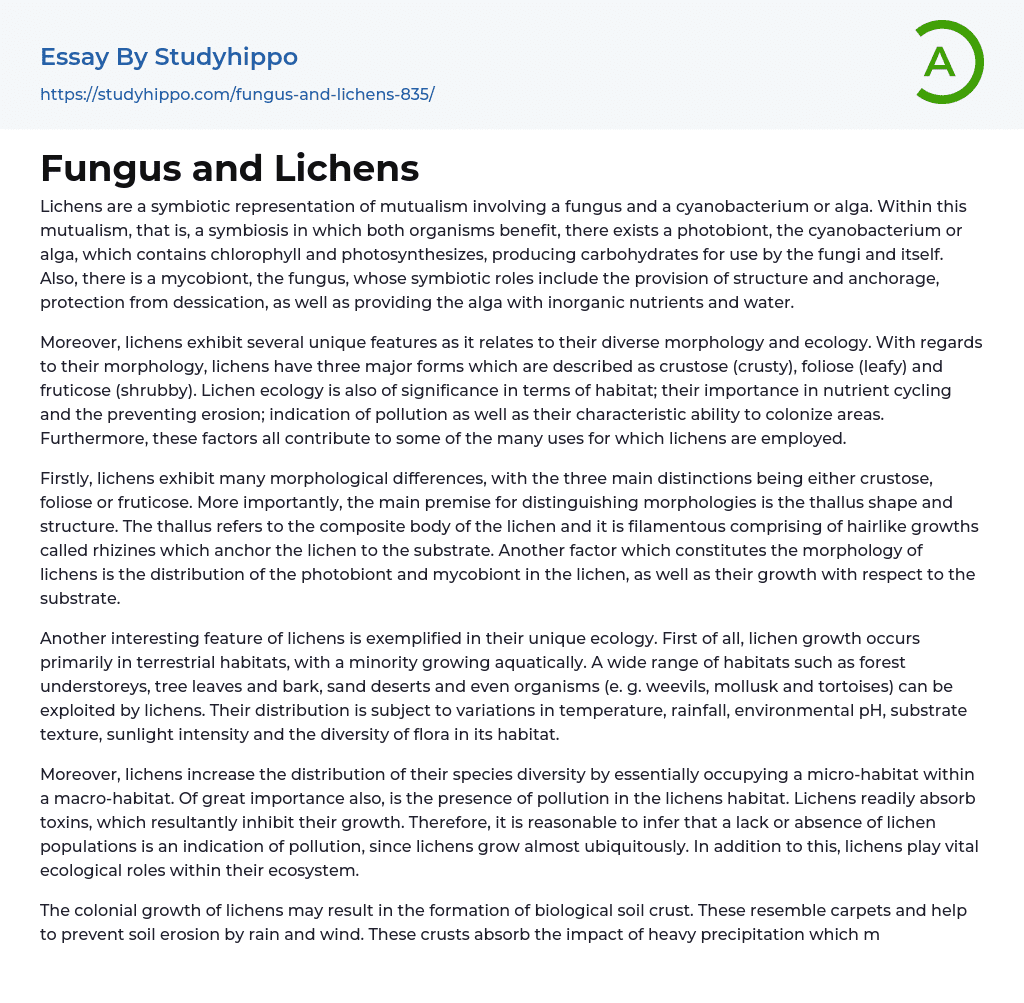Lichens are a type of mutualistic symbiosis that involve a fungus and a cyanobacterium or alga. This mutualism benefits both organisms. The photobiont, which is the cyanobacterium or alga, has chlorophyll and is capable of photosynthesis. This process allows for the production of carbohydrates that are used by both the fungi and the photobiont. The mycobiont, which is the fungus, plays various symbiotic roles such as providing structure and anchorage, protecting from dessication, and supplying the alga with inorganic nutrients and water.
In addition, lichens possess various distinctive characteristics in relation to their wide range of shapes and ecological habits. In terms of shape, lichens can be categorized into three primary types known as crustose (having a crust-like appearance), foliose (resembling leaves), and fruticose (resembling shrubs). Lichen ecology is also significant when it comes to their habitats, inclusion in nutrient cycling, er
...osion prevention, pollution detection, and their distinct capability to inhabit new areas. All of these aspects contribute to the numerous applications for which lichens are utilized.
Firstly, lichens demonstrate various morphological variations, characterized as crustose, foliose or fruticose. The main criteria for distinguishing these morphologies is the shape and structure of the thallus. The thallus is the collective body of the lichen, consisting of filamentous components known as rhizines that attach the lichen to the substrate. Additionally, the distribution of the photobiont and mycobiont within the lichen, as well as their growth in relation to the substrate, also contribute to the overall morphology of lichens.
Lichens have a distinctive ecology, which is showcased by their notable characteristics. Primarily, lichen growth occurs in terrestrial environments, although some can be found in aquatic habitats. These organisms can inhabit divers
habitats including forest understoreys, tree leaves and bark, sand deserts, and even living organisms like weevils, mollusks, and tortoises. The distribution of lichens is affected by factors such as temperature, rainfall, pH levels in the environment, substrate texture, sunlight intensity, and the variety of plant life existing in their habitat.
Moreover, lichens increase their range of species by inhabiting a small environment within a larger one. An important factor is the presence of pollution in the habitat where lichens reside. Lichens have a high capacity for absorbing harmful substances that impede their growth. Therefore, it can be concluded that the lack of lichen populations indicates pollution because lichens thrive abundantly. Furthermore, lichens perform essential ecological functions within their ecosystem.
The presence of lichens can lead to the development of biological soil crust, which resembles carpets and plays a role in preventing soil erosion caused by rain and wind. These crusts absorb the impact of heavy precipitation, which could otherwise wash away the top layer of soil. Additionally, they create an uneven and coarse soil surface, forming depressions that capture and slow down the flow of water. As a result, water is given more time to penetrate the underlying soil. Moreover, biological crusts also provide habitats for smaller organisms.
- Microbiology essays
- Bacteria essays
- Cell essays
- Enzyme essays
- Photosynthesis essays
- Plant essays
- Natural Selection essays
- Protein essays
- Viruses essays
- Cell Membrane essays
- Human essays
- Stem Cell essays
- Breeding essays
- Biotechnology essays
- Cystic Fibrosis essays
- Tree essays
- Seed essays
- Coronavirus essays
- Zika Virus essays
- Accounting essays
- Marketing essays
- Automation essays
- Business Cycle essays
- Business Model essays
- Business Operations essays
- Business Software essays
- Corporate Social Responsibility essays
- Infrastructure essays
- Logistics essays
- Manufacturing essays
- Multinational Corporation essays
- Richard Branson essays
- Small Business essays
- Cooperative essays
- Family Business essays
- Human Resource Management essays
- Sales essays
- Market essays
- Online Shopping essays
- Selling essays
- Strategy essays
- Management essays
- Franchising essays
- Quality Assurance essays
- Business Intelligence essays
- Corporation essays
- Stock essays
- Shopping Mall essays
- Harvard Business School essays
- Harvard university essays




